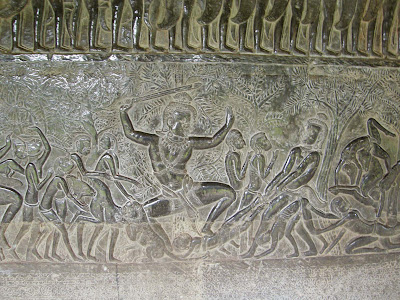by Fabian Klavert
When entering any temples within the Angkor complex in Siem Reap, aside from the mesmerizing architecture, the first things you would notice are the intricate details of the stone carved murals. Each uniquely hand carved during different reigns of Angkor kings, the bas-reliefs often suits the purpose of serving religious beliefs, validating these historical landmarks as a successful outlet for religious expression.
Although the walls have stood still for countless centuries, stories written in stones within these hand carved murals have lived on to tell the tales of ancient Angkor civilization, uncovering historic events, cultural beliefs, and important figures which nowadays still fascinate archeologists, historians, and even tourists.
The most famous of them all, the Angkor Wat was built in early 12th century by King Suryavarman II as the state's temple and capital city. Separated by three different tiers and enclosed in a man made moat, each level and wings of the temple distinctively depicts various Hindu mythologies as a dedication to the Hindu gods, particularly Vishnu.
From the battle of the gods to the famous 'Churning of the Ocean Milk' in the east gallery, a uniform motif bounding these epic tales are the Apsaras. A Hindu mythological creature said to have been released due to the churning of the ocean milk to acquire an elixir of immortality, these celestial figures are scattered throughout Angkor Wat and all temples in Angkor.
Depicted as proficient dancers, each of Angkor Wat's apsaras are unique. With around 1700 figures lovingly hand carved, the elaborate headwear, jewelry, body posture and facial expressions define each one, whether they appear in duet, trios or solo. The dance offered to the Gods by apsaras have transformed into the Khmer traditional dance and one of Cambodia's main attraction.
While Angkor Wat focused on the depictions of aspects of Hinduism, Bayon temple, located at the heart of Angkor Thom, approximately 1500 meters from the south gate. Built by Jayavarman VII in the late 12th to early 13th century, the temple's bas-reliefs are dominated by the influence of Buddhism. The Bayon is broken down into three different section: the outer gallery, the inner gallery, and the upper terrace.
The outer gallery depicts the everyday lifestyle of the Angkor civilization in addition to historic events. This includes but are not limited to market and trading scenes, cockfights, festivals, and scenes with battles and processions. Each stone panel weaves a complicated tale of history and mythology. Figures within the outer gallery are easier to decipher due to its simplicity.
Personally, I feel that a quick research on historical knowledge of Buddhist and Hindu mythologies is recommended to understand bas-reliefs in the inner gallery, before you visit Angkor Wat. The inner gallery portrays similar mythologies as Angkor Wat's, with one being the Churning of The Ocean Milk located in the north of the western gapura.
On the other hand, the upper terrace of Bayon, aside from the common apsara motif on top of gapuras, is devoted to the sculpture of numerous Buddha heads on top of elevated towers. The 56 hand-sculpted heads, each representing different provinces of Cambodia, has become the central attraction of Bayon. The faces on the stone towers are arguably to be either the depiction of Jayavarman VII, founder of the temple or the Buddha of compassion, Avalokiteśvara. Simply put, it is these hand carved that makes the Bayon an incredible sight to see.
Another temple also built between the 12th and 13th century by Jayavarman VII and my personal favorite, is the Ta Prohm (Ed: Made famous by Tomb Raider and of course, Angelina Jolie) . Scattered throughout the jungle, the moss covered stones and tree barks that envelope the ruins gives it a certain ethereal beauty that distinguishes Ta Prohm from other temples.
Unlike other temples, the layout of Ta Prohm is a flat style in contrast to Angkor Wat and Bayon's multi-tiered pyramid. Aside from the common motifs in Khmer architecture, Ta Prohm hides deep secrets as there are few narrative bas-reliefs. This is due to Hindu iconoclasts destroying Buddhist narrative murals in Ta Prohm after the death of Jayavarman VII in 1215.
Nevertheless, it was breathtaking to see the convergence of green and gray, making this manmade landmark seem to belong to the bosom of nature itself. The compilation of bas-reliefs within the Angkor complex forms a gigantic story book of the history of ancient Angkor civilization. It is all illustrated to avoid mundane word by word reading. It does not require you to flip pages. It cannot be misplaced. And it will definitely be there whenever needed.
Pretty genius right?
Thursday, July 10, 2008
Angkor Temples and the Bas-Reliefs
Subscribe to:
Post Comments (Atom)


No comments:
Post a Comment